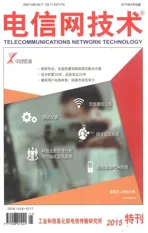Filtered-OFDM
——EnablingFlexible Waveformforthe5GCellularNetworks
2015-10-20XiZhangChengduResearchDevelopmentCentreHuaweiTechnologiesCoLtdPeoplesRepublicofChinaMingJiaOttawaResearchDevelopmentCentreHuaweiTechnologiesCanadaCoLtdCanadaLeiChenChengduResearchDevelopmentCentreHuaweiTechnologiesCoLtdPeoplesRepublicofC
Xi Zhang ChengduResearch&DevelopmentCentre,HuaweiTechnologiesCo.,Ltd., People'sRepublicofChinaMingJia OttawaResearch&DevelopmentCentre,HuaweiTechnologiesCanadaCo., Ltd.,CanadaLeiChen ChengduResearch&DevelopmentCentre,HuaweiTechnologiesCo.,Ltd., People’sRepublicofChinaJiangleiMa OttawaResearch&DevelopmentCentre,HuaweiTechnologiesCanadaCo., Ltd.,CanadaJingQiu ChengduResearch&DevelopmentCentre,HuaweiTechnologiesCo.,Ltd., People’sRepublicofChina
Filtered-OFDM
——EnablingFlexible Waveformforthe5GCellularNetworks
Xi Zhang ChengduResearch&DevelopmentCentre,HuaweiTechnologiesCo.,Ltd., People'sRepublicofChina
MingJia OttawaResearch&DevelopmentCentre,HuaweiTechnologiesCanadaCo., Ltd.,Canada
LeiChen ChengduResearch&DevelopmentCentre,HuaweiTechnologiesCo.,Ltd., People’sRepublicofChina
JiangleiMa OttawaResearch&DevelopmentCentre,HuaweiTechnologiesCanadaCo., Ltd.,Canada
JingQiu ChengduResearch&DevelopmentCentre,HuaweiTechnologiesCo.,Ltd., People’sRepublicofChina
To deal with the expected diversification on traffic types,the fundamental waveform of the upcoming 5G standard must be sufficiently flexible.In the 4th generation wireless networks(e.g.,cellular LTE and Wi-Fi 802.11ac),orthogonal frequency division multiplexing(OFDM)has been widely adopted to combat frequency selectivityandthusimprovethespectrumefficiency.Holdingvariousadvantagessuchasbackwardcompatibility withLTE,easeofhardwareimplementation,time-localizedlow-latencytransmissionandstraightforwardcombinationwithmulti-antennatransmission,OFDMwillremainasanimportantwaveformcandidatefor5G.However, OFDMaloneappearstobeinsufficientintermsoftherequirementsfacedby5Gwaveform,suchashighflexibility toaccommodatedifferentwaveformnumerologiesforanefficientsupportofdiversifiedtraffictypesandchannel characteristics.Inthiswork,wepresentanewwaveformformat,namedasfiltered-OFDM(f-OFDM)andillustrate itspotentialandbenefitsforservingastheunderlyingwaveformof5G.
5G,airinterface,flexibility,waveform,OFDM,filtered-OFDM
1 Introduction
To enhance the spectrum efficiency in frequencyselective channels,orthogonal frequency division multiplexing(OFDM)hasbeenwidelyadoptedinthe4thgeneration wireless networks.Nevertheless,in terms of the new requirementsfacedby5Gwaveform,OFDMappearsinsufficient:
●With unified numerology across the system bandwidth,itisdifficultforOFDMtosupportthevarioustraffic typeswithoutmakingtradeoff.
●Theout-of-bandemission(OOBE)performanceof OFDM is unsatisfactory,with which 10%of the system bandwidthisreservedasguardbandandleftunused.
●To avoid inter-symbol/channel interference,stringent time and frequency synchronization is required by OFDM,resultinginheavysignalingoverhead.
To enable flexible waveform and also address other challengesof5Gwaveform,inthiswork,wepresentanew waveform format,named as filtered-OFDM(f-OFDM). Based on subband splitting and filtering,independentOFDM signals(and possibly other waveforms)are closely contained in the assigned frequency band.Within each subband,the inter-symbol orthogonality is givenupintentionally,intradeforalowerOOBEandthefollowingadvantages:
●Reduced synchronization overhead and support for asynchronous transmission amongadjacentsubbands.
●Minimized guard band consumption andthusimprovedspectrumutilization.
●Tailored services for different traffic types,i.e.,with suitable waveform and optimizednumerology.
In general,the requirements faced by 5G waveformcanbefulfilledbyf-OFDMandthe overallspectrumefficiencycanbeenhanced.
2 Generalframework
The downlink transceiver structure of f-OFDM is depicted in Figure 1,shown at the topofthenextpage.Typically,independentOFDMsystems (again,possiblyotherwaveforms)withdifferentnumerologies,i.e.,subcarrier(SC)spacing,length of cyclic prefix (CP)and transmission time interval(TTI),are to be contained in different subbands,separated by filters.The subbands do not overlap with each other,and between subbands,asmallguardbandarereservedtoaccommodateinter-subband interference.The waveform used in the uplink of4GLTE,i.e.,DFT-spread-OFDM,canalsobecombined withsubband-basedfilteringinasimilarmanner.
AsillustratedinFigure2,thetime-frequencyarrangement of f-OFDM is very flexible.Two examples are given asfollows:

Figure2 Flexibilityandcoexistenceif waveformswithf-OFDM
●To avoid collisions among fast-moving vehicles, the TTI duration is shortened and the subcarrier spacing is enlargedtoprovideultra-lowlatencyandhighreliability.
●For machine type communications,a single-carrier waveform is included to enable wide coverage with low power consumption,while the TTI duration is extended to improvereliabilityinquasi-staticchannels.
Ingeneral,differentwaveformsandnumerologiescan co-existundertheframeworkoff-OFDM,andthetime-frequency arrangement might be dynamically adjusted based onthetrafficvolumeofthetime.

Figure1 Dowrlinktransceiverstructureof f-OFDM
In terms of evolution,f-OFDM provides both backward and forward compatibility.At the initial stage,the 10%guard band in 4G LTE networks can be invoked for data transmission through f-OFDM,and no change is requiredforthelegacyLTEmobiledevices.Inthelongrun, thebandwidthallocatedtoLTEnetworkscanbereducedto alimitedlevel,whiletheremainingbandwidthwillbereallocatedto5Gforbetterspectrumefficiencyviaf-OFDM.
3 Designconsiderations
To enable subband-based filtering and thus enjoy the benefitspromisedbyf-OFDM,properlydesignedfiltersare needed.In general,the filter design involves the trade off betweenthetime-andfrequency-domaincharacteristics.A fewdesignguidelineshavebeensummarizedasfollows:
●The energy spread in the time domain shall be constrained such that the inter-symbol interference introduced byfilteringisinconsequential.
●Itisworthwhiletopursueasharptransitionregionin the frequency domain such that the guard band consumptioncanbeminimized.
●To reduce the computational complexity,the overlap-savemethodisrecommendedtoimplementthefiltersin thefrequencydomain.
●To achieve a flexible subband allocation,a system aticandconvenientapproachthatallowsforonlinegenerationoffiltersisalsodesired.
Withproperlydesignedfilters,theguardbandbetween adjacentsubbandscanbeminimizedtomaximizethespectrumutilization.Inpractice,theguardbandwilllikelyhave a width that belongs to a finite set.Here,we take the standard subcarrier spacing in LTE as a basic element,and set theguardbandasapluralityofthestandardsubcarrierspacing,whichishenceforthreferredtoasguardtones.Oursimulationresultshaverevealedthat:
●With equal transmit power in adjacent subbands,to ensurethattheblock-errorratedoesnotchangeinthepresenceofinterferencefromadjacentsubbands:
——For low to medium modulation orders(e.g., QPSKand16QAM),noguardtoneisrequired.
——For high-order modulation(e.g.,64QAM),two guardtonesarealreadysufficient.
●Even if the transmit power in adjacent subbands is lifted by 10 dB,two guard tones are still sufficient for suppressingtheinter-subbandinterference.
●If combined with proper scheduling,e.g.,putting high-order modulations away from the subband edges,the guardtoneconsumptioncanbeneglected.
4 Simulationresults
To support our claims,two parts of simulation results arepresented.Inthefirstpart,the20MHzbandwidthof4G LTE is divided into three subbands.The 1st and 3rd have 1MHz bandwidth,corresponds to the guard bands in LTE. The 2nd subband has 18MHz bandwidth,corresponds to the bandwidth loaded in LTE systems.Standard LTE numerologyisappliedacrossthreesubbands,withdifferent numbersofguardtonesbetweenthem.Ahalf-symboldelay iscreatedbetweenadjacentsubbandstosimulateinter-subbandinterferenceandasynchronoustransmission.ThesimulationsetupissummarizedinTable1,andotherunlistedissues are set to follow the LTE standard.As depicted in Figure3,evenwiththeutilizationofthe1MHzguardbands,the OOBE of f-OFDM is still much lower than that of OFDM. As shown in Figure 4,with f-OFDM,the 1st subband(i.e., the guard band in LTE systems)is efficiently utilized for data transmission with a block-error rate(BLER)that is similar to that of a single OFDM system without interference from adjacent subbands.The BLER in the 2nd subbandissimilartothatofthe1stsubbandandthusisomitted forthesakeofbrevity.

Table1 Simulationsetup

Figure3 PSDof OFDMandf-OFDM

Figure4 BLERof OFDMandf-OFDMin1stsubband
In the second part,initial efforts have been taken to investigate the throughput performance of f-OFDM due to numerology adaptation for various application scenarios.In this simple experiment,fourtypesofscenarioswith different channel dispersion characteristics are considered:1.Pedestrian,2.Urban,3.Highway,4.V2V.TheconventionalOFDMistakenasabenchmark.Thenumerology of OFDM is limited by the worst case,e.g.,extended CPis used to combat rich multipath scattering in urban environment,and 10%bandwidth is reserved as guard band.With f-OFDM,the guard tone consumption is minimized and the bandwidth available is evenly split up into four subbands.In each subband,the OFDM numerology is optimized according to the performancerequirementsandchannelcharacteristics,assummarizedinTable2.As shown inFigure5,significantthroughputgainscanbeachievedineachsubbandandintotal.The throughput gain comes from not only the savings on guard tone,butalsotheadaptationtotheapplicationscenariosand channelcharacteristics,i.e.,reducedCPdurationforsmaller multi-path delay spread and reduced subcarrier spacing forstrongerfrequencyselectivity.Inthisexample,thetotal throughput gain of f-OFDM over OFDM is up to 46%, whichisveryattractive.
5 Conclusion
In this work,we presented filtered-OFDM——an enablerforflexiblewaveform,designedtomeettheexpectations upon the 5G cellular networks.After outlining the general framework and design considerations of f-OFDM, simulation validations are provided to support our claims, withwhichencouragingresultswereobserved(e.g.,46%of throughput gain over OFDM).In general,f-OFDM allows the5Gairinterfacetobettersupportdiversetraffictypes,to reduce(oreveneliminate)theguardtoneconsumption,and to support asynchronous transmissions across subbands, andyetprovidesbothbackwardandforwardcompatibility. Tosumup,filtered-OFDMcanserveasakeyenablerforthe 5Gsoftwaredefinedflexibleairinterface.

Table2 Optimizednumerologyfordifferentscenarios

Figure5 Normalizedthroughputof OFDMandf-OFDM
[1]G.Wunder,P.Jung,M.Kasparick,T.Wild,F.Schaich,Y. Chen,S.Brink,I.Gaspar,N.Michailow,A.Festag,L.Mendes, N.Cassiau,D.Kténas,M.Dryjanski,S.Pietrzyk,B.Eged,P. Vago,and F.Wiedmann.5GNOW:Non-orthogonal,Asynchro nousWave Forms for Future MobileApplications.IEEE Com mun.2,2014
[2]W.H.Chin,F.Zhong,and R.Haines.Emerging Technologies and Research Challenges for 5g Wireless Networks.IEEE WirelessCommun.4,2014
[3]J.G.Andrews,S.Buzzi,W.Choi,S.V.Hanly,A.Lozano,A.C. K.Soong,and J.C.Zhang.What Will 5G Be?IEEE J.Select. AreasCommun.6,2014
[4]A.Şahin,I.Güvenç,and H.Arslan.ASurvey on Multicarrier Communications:Prototype Filters,Lattice Structures,and ImpleMentationAspects.IEEECommun.8,2014
[5]P.Banelli,S.Buzzi,G.Colavolpe,A.Modenini,F.Rusek,and A.Ugolini.Modulation Formats and Waveforms for 5G Net Works:Who Will Be the Heir of OFDM?An Overview of Alternative Mod Ulation Schemes for Improved Spectral Efficiency.IEEESignalProcess.11,2014
2015-05-05)
